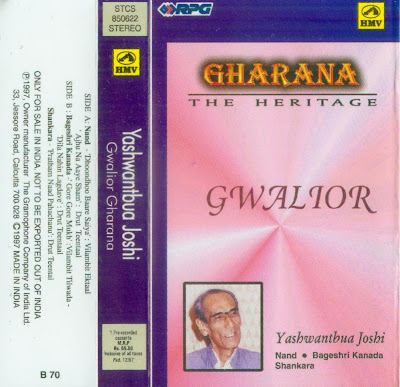The last great singer of the glorious Agra Gharana
Side 1:
Raga Anandi (20:56)
Side 2:
1. Raga Kamod 6:53)
2. Raga Husaini Kanada (5:12)
3. Raga Bhairavi (Dadra) (7:17)
Sharafat Hussain Khan (1930 - 1985) was amongst the most brilliant Khayal vocalists of the post-independence era. He represented the Agra Gharana (stylistic lineage), and was unanimously regarded as the most illustrious heir to the legacy of his principal mentor, the legendary Ustad Faiyyaz Khan (1886 - 1950).
Sharafat Hussain Khan was born in July, 1930, to Ustad Liaquat Hussain Khan, a court musician in the erstwhile Jaipur State, and Alla Rakhi Beghum. From his father's side, Sharafat was a descendant of Inayet Hussain Khan (1845 - 1936), founder of Atrauli Gharana, and from his mother's side, and of his maternal grandfather Mehboob Khan (Daras Piya), also of the Atrauli Gharana, but whose music was greatly influenced by the Rangile Gharana of his mother's family, founded by Ramzan Khan (1759 - 1806). In early childhood, Sharafat was trained by his father. When Sharafat was only eight years old, his prodigious talent impressed the legendary Faiyyaz Khan during one of his visits to Atrauli. The maestro, without a son despite three marriages, adopted Sharafat, and took him away forthwith to Baroda to groom him as his heir.
Sharafat was a child prodigy, who rose meteorically after his adoption by Faiyyaz Khan. At the age of eight, he made a stunning debut at the influential Matunga Music Circle in Mumbai. This triggered off invitations to perform at the All India Music Conference at Allahabad, and the All Bengal Conference in Kolkata. When he was eleven, he was hailed as the "Rising Sun" of vocalism at the Gaya Conference. By the age of twelve, he has made his first disc with HMV/ EMI, and topped the prestigious Baroda State Music Competition.
Sharafat was only 20, when Faiyyaz Khan died. Thereafter, he started studying with his maternal uncle, Ustad Ata Hussain Khan of the allied Atrauli - Rangile Lineage. Soon thereafter, he acquired a third guide - his scholarly father-in-law, Vilayat Hussain Khan of the Agra Lineage. Thus, like his foster-father, Sharafat Hussain came to represent a magnificent confluence of three intimately connected lineages - Agra, Atrauli, and Rangile.
While still in his 30s, Sharafat became amongst the busiest vocalists in India, and enjoyed a continuous run of sucess for two decades (1965 - 1985). Along with popularity came the honours. He was made an Honorary Fellow of the Performing Arts Academy of Uttar Pradesh (Northern Provinces) and decorated with the Padma Shree by the President of India. In 1985, Sangeet Natak Akademi ( The National Performing Arts Academy) held a special ceremony to honour him shortly before he succumbed to lung cancer at the age of 55. He also got a Tansen Award.
from: http://www.purnimasen.com/guru.htm
Sharafat Hussain Khan was born in July, 1930, to Ustad Liaquat Hussain Khan, a court musician in the erstwhile Jaipur State, and Alla Rakhi Beghum. From his father's side, Sharafat was a descendant of Inayet Hussain Khan (1845 - 1936), founder of Atrauli Gharana, and from his mother's side, and of his maternal grandfather Mehboob Khan (Daras Piya), also of the Atrauli Gharana, but whose music was greatly influenced by the Rangile Gharana of his mother's family, founded by Ramzan Khan (1759 - 1806). In early childhood, Sharafat was trained by his father. When Sharafat was only eight years old, his prodigious talent impressed the legendary Faiyyaz Khan during one of his visits to Atrauli. The maestro, without a son despite three marriages, adopted Sharafat, and took him away forthwith to Baroda to groom him as his heir.
Sharafat was a child prodigy, who rose meteorically after his adoption by Faiyyaz Khan. At the age of eight, he made a stunning debut at the influential Matunga Music Circle in Mumbai. This triggered off invitations to perform at the All India Music Conference at Allahabad, and the All Bengal Conference in Kolkata. When he was eleven, he was hailed as the "Rising Sun" of vocalism at the Gaya Conference. By the age of twelve, he has made his first disc with HMV/ EMI, and topped the prestigious Baroda State Music Competition.
Sharafat was only 20, when Faiyyaz Khan died. Thereafter, he started studying with his maternal uncle, Ustad Ata Hussain Khan of the allied Atrauli - Rangile Lineage. Soon thereafter, he acquired a third guide - his scholarly father-in-law, Vilayat Hussain Khan of the Agra Lineage. Thus, like his foster-father, Sharafat Hussain came to represent a magnificent confluence of three intimately connected lineages - Agra, Atrauli, and Rangile.
While still in his 30s, Sharafat became amongst the busiest vocalists in India, and enjoyed a continuous run of sucess for two decades (1965 - 1985). Along with popularity came the honours. He was made an Honorary Fellow of the Performing Arts Academy of Uttar Pradesh (Northern Provinces) and decorated with the Padma Shree by the President of India. In 1985, Sangeet Natak Akademi ( The National Performing Arts Academy) held a special ceremony to honour him shortly before he succumbed to lung cancer at the age of 55. He also got a Tansen Award.
from: http://www.purnimasen.com/guru.htm
































